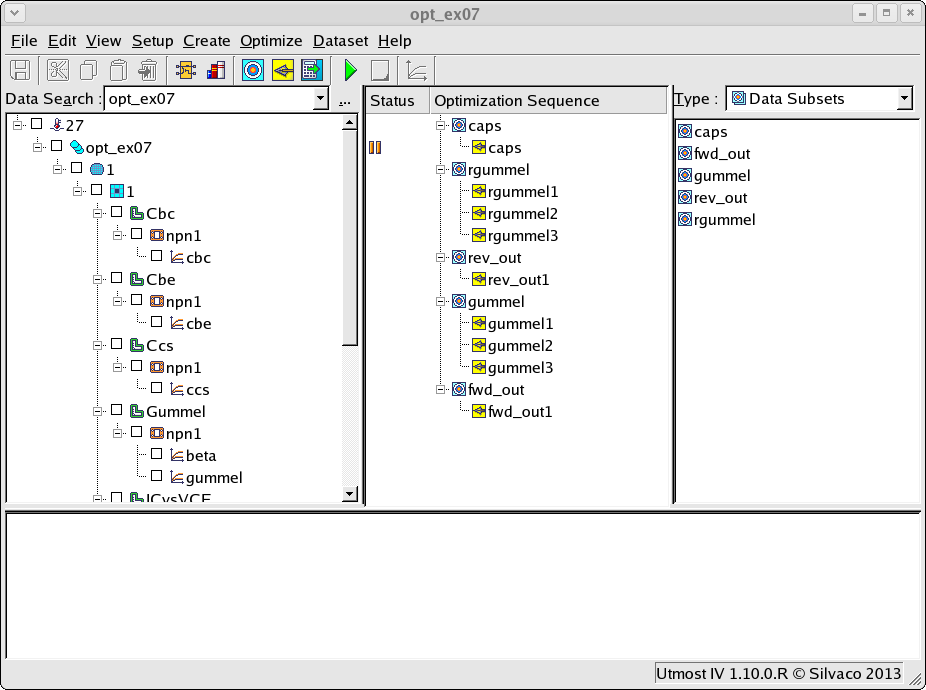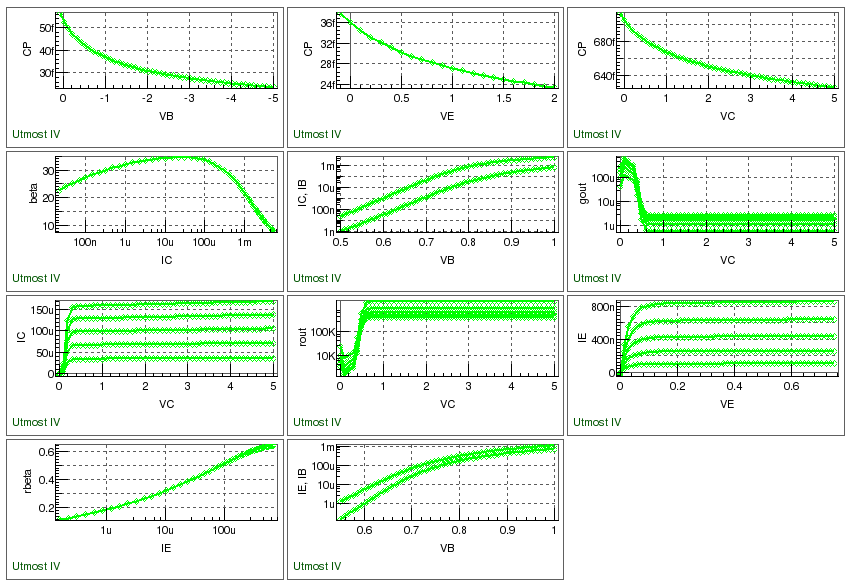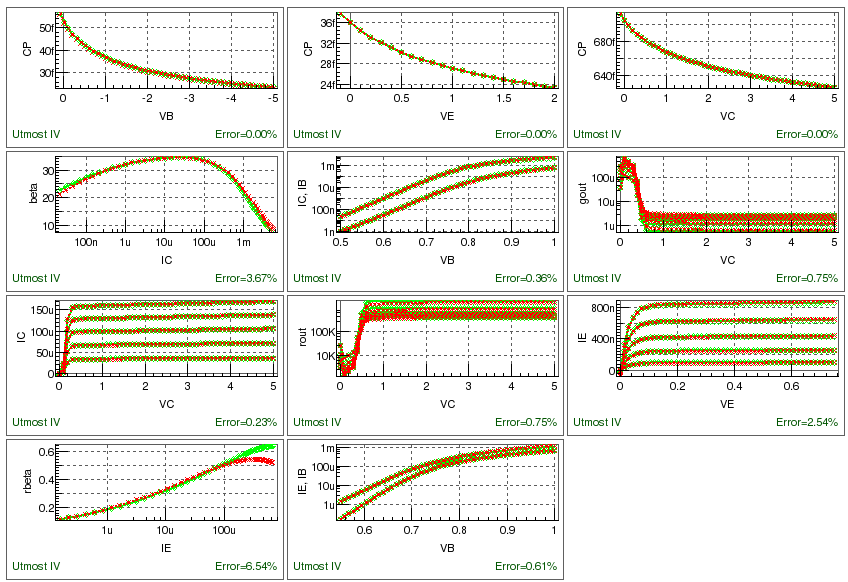opt_ex07 : VBIC Bipolar Model Extraction
Requires: Utmost IV, SmartSpice, SmartView
Minimum Versions: Utmost IV 1.10.6.R, SmartSpice 4.10.2.R, SmartView 2.28.2.R
This example describes how to extract a VBIC model for a bipolar transistor. To extract the model, typical forward and reverse operation DC characteristics and reverse bias capacitance characteristics of each junction are required.
The project file opt_ex07.prj and the data file opt_ex07.uds for this example should be loaded into your database. When opened, the project will look as shown in opt_ex07_01.png and when plotted, the example measured data will look as shown in opt_ex07_02.png .
The optimization sequence, which fully automates the extraction of this VBIC bipolar model example, has five sections. The objective of each section is to isolate a device characteristic and then to optimize only those model parameters which account for this device behaviour.
The VBIC bipolar model couples the capacitance and the charge equations together. Therefore, it is important to extract the capacitance parameters first to avoid having to readjust the DC model parameters later.
The first section extracts the CJE , PE , ME , CJC , PC , MC , CJCP , PS , and MS model parameters which describe the reverse bias capacitance characteristics of all three transistor junctions.
Once the capacitance parameters are extracted, the second section will extract the reverse Gummel parameters IS , NR , IBCI , IBCN , NCN , IKR , RCI , and RBI . Then the third section will extract the reverse output characteristic parameters VER and IKR .
As the forward operation of the transistor is more important than the reverse, these model parameters are extracted last. In this way, the goodness of fit to the reverse data can be sacrificed if necessary to achieve the best fit to the forward data.
The fourth section extracts the parameters IS , NF , IBEI , IBEN , NEN , RE , IKF to fit to the forward Gummel data and finally the fifth section extracts the model parameters IKF and VEF to fit to the forward output characteristics.
If the overall fit to the data is not acceptable at this point, it may be necessary to repeat the sequence multiple times. Also, if there is a marked difference in forward and reverse saturation current ( IS ) values, it is possible to use an extension to the VBIC model which utilizes the parameter ISRR which represents the ratio between the saturation current in forward and reverse. This parameter should be added to the rgummel1 optimization setup in place of the IS parameter and must be extracted after IS has already been extracted for the forward data.
On completion of the sequence, the measured versus simulated characteristics should be as shown in opt_ex07_03.png . The model card can then be exported into an external model library file as shown in the output file opt_ex07.lib.
opt_ex07.lib
.LIB demo .MODEL npn NPN ( +LEVEL = 4 TNOM = 27 RCI = 46.5798 +RCX = 0 VO = 0 GAMM = 0 +HRCF = 1 RBX = 0 RBI = 138.392 +RE = 18.0501 RS = 0 RBP = 0 +IS = 8.51658e-17 NF = 1 NR = 1.00148 +FC = 0.5 CBEO = 0 CJE = 3.59e-14 +PE = 0.686403 ME = 0.313618 AJE = -0.5 +CBCO = 0 CJC = 5.25e-14 QCO = 0 +CJEP = 0 PC = 0.551297 MC = 0.346841 +AJC = -0.5 CJCP = 7.05e-13 PS = 0.49999 +MS = 0.0493008 AJS = -0.5 IBEI = 2.30653e-18 +WBE = 1 NEI = 1 IBEN = 7.73882e-15 +NEN = 1.77629 IBCI = 7.14413e-17 NCI = 1 +IBCN = 5e-13 NCN = 1.44694 AVC1 = 0.0003 +AVC2 = 1e-05 ISP = 0 WSP = 1 +NFP = 1 IBEIP = 0 IBENP = 0 +IBCIP = 0 NCIP = 1 IBCNP = 0 +NCNP = 2 VEF = 82.0378 VER = 14.8983 +IKF = 0.00177231 IKR = 0.00176481 IKP = 0 +TF = 0 QTF = 0 XTF = 0 +VTF = 0 ITF = 0 TR = 0 +TD = 0 KFN = 0 AFN = 1 +BFN = 1 XRE = 0 XRB = 0 +XRC = 0 XRS = 0 XVO = 0 +EA = 1.12 EAIE = 1.12 EAIC = 1.12 +EAIS = 1.12 EANE = 1.12 EANC = 1.12 +EANS = 1.12 XIS = 3 XII = 3 +XIN = 3 TNF = 0 TAVC = 0 +RTH = 0 CTH = 0 SELFT = 0 +DTMAX = 0 ) .ENDL demo
opt_ex07.uds
Utmost IV CSV Data Logfile Format Version 1 Copyright (c) 1984 - 2016 Silvaco, Inc. All rights reserved DataSetStart DataSetName, Cbc MeasurementType, LCR BatchName, opt_ex07 WaferName, 1 DieName, 1 GroupName, 1, 0, 12000 DeviceName, npn1 Temperature, 27 FabDate, 23 Apr 2007 UserDate, 23 Apr 2007 WaferDiameter, 200 DieSize, 20, 20 NodeNames, C B E S LCRSource, B, C, 1e+06, V, 0 LCRTarget, CP Sweep, 1, V_LCR, LIN, 0.1, -5, -0.1, CALCULATED Constant, V, E, 0, 0.1, 0.0 Constant, V, C, 0, 0.1, 0.0 Constant, V, S, 0, 0.1, 0.0 Function, VB, VC + V_LCR Plot, cbc, XY (LIN LIN), VB, CP DataArray, CP 5.6274e-14 5.25e-14 4.95507e-14 4.71557e-14 4.51556e-14 4.34492e-14 4.19687e-14 4.06667e-14 3.95087e-14 3.8469e-14 3.75281e-14 3.66708e-14 3.58848e-14 3.51604e-14 3.44897e-14 3.38661e-14 3.32841e-14 3.27391e-14 3.22272e-14 3.17451e-14 3.12898e-14 3.08588e-14 3.04501e-14 3.00615e-14 2.96916e-14 2.93387e-14 2.90016e-14 2.8679e-14 2.83699e-14 2.80734e-14 2.77886e-14 2.75146e-14 2.72509e-14 2.69967e-14 2.67515e-14 2.65147e-14 2.62859e-14 2.60645e-14 2.58502e-14 2.56426e-14 2.54413e-14 2.5246e-14 2.50564e-14 2.48722e-14 2.46932e-14 2.4519e-14 2.43496e-14 2.41846e-14 2.40239e-14 2.38672e-14 2.37144e-14 2.35654e-14 DataSetFinish DataSetStart DataSetName, Cbe MeasurementType, LCR BatchName, opt_ex07 WaferName, 1 DieName, 1 GroupName, 1, 0, 12000 DeviceName, npn1 Temperature, 27 FabDate, 23 Apr 2007 UserDate, 23 Apr 2007 WaferDiameter, 200 DieSize, 20, 20 NodeNames, C B E S LCRSource, E, B, 1e+06, V, 0 LCRTarget, CP Sweep, 1, V_LCR, LIN, -0.1, 2, 0.1, CALCULATED Constant, V, C, 0, 0.1, 0.0 Constant, V, B, 0, 0.01, 0.0 Constant, V, S, 0, 0.1, 0.0 Function, VE, VB + V_LCR Plot, cbe, XY (LIN LIN), VE, CP DataArray, CP 3.77173e-14 3.59e-14 3.4401e-14 3.31335e-14 3.20411e-14 3.10853e-14 3.02387e-14 2.94809e-14 2.87968e-14 2.81746e-14 2.76051e-14 2.70809e-14 2.65961e-14 2.61456e-14 2.57255e-14 2.53323e-14 2.4963e-14 2.46154e-14 2.42871e-14 2.39764e-14 2.36818e-14 2.34017e-14 DataSetFinish DataSetStart DataSetName, Ccs MeasurementType, LCR BatchName, opt_ex07 WaferName, 1 DieName, 1 GroupName, 1, 0, 12000 DeviceName, npn1 Temperature, 27 FabDate, 23 Apr 2007 UserDate, 23 Apr 2007 WaferDiameter, 200 DieSize, 20, 20 NodeNames, C B E S LCRSource, C, S, 1e+06, V, 0 LCRTarget, CP Sweep, 1, V_LCR, LIN, -0.1, 5, 0.1, CALCULATED Constant, V, E, 0, 0.1, 0.0 Constant, V, B, 0, 0.01, 0.0 Constant, V, S, 0, 0.1, 0.0 Function, VC, VS + V_LCR Plot, ccs, XY (LIN LIN), VC, CP DataArray, CP 7.12799e-13 7.05e-13 6.98691e-13 6.93402e-13 6.88852e-13 6.84863e-13 6.81315e-13 6.78121e-13 6.75218e-13 6.72559e-13 6.70106e-13 6.67831e-13 6.65709e-13 6.63723e-13 6.61855e-13 6.60093e-13 6.58426e-13 6.56844e-13 6.55339e-13 6.53905e-13 6.52534e-13 6.51222e-13 6.49964e-13 6.48756e-13 6.47594e-13 6.46474e-13 6.45395e-13 6.44352e-13 6.43344e-13 6.42369e-13 6.41424e-13 6.40508e-13 6.39619e-13 6.38756e-13 6.37917e-13 6.371e-13 6.36306e-13 6.35531e-13 6.34777e-13 6.34041e-13 6.33323e-13 6.32621e-13 6.31936e-13 6.31267e-13 6.30612e-13 6.29971e-13 6.29344e-13 6.2873e-13 6.28128e-13 6.27539e-13 6.2696e-13 6.26394e-13 DataSetFinish DataSetStart DataSetName, Gummel MeasurementType, DC BatchName, opt_ex07 WaferName, 1 DieName, 1 GroupName, 1, 0, 12000 DeviceName, npn1 Temperature, 27 FabDate, 23 Apr 2007 UserDate, 23 Apr 2007 WaferDiameter, 200 DieSize, 20, 20 NodeNames, C B E S Sweep, 1, V, B, LIN, 0.5, 1, CALCULATED, 51, 0.1 Constant, V, E, 0, 0.1, 0.0 Constant, V, S, 0, 0.1, 0.0 Constant, V, C, 2, 0.1, 0.0 Target, I, B Target, I, C Function, beta, IC / IB Plot, beta, XY (LOG LIN), IC, beta Plot, gummel, XY (LIN LOG), VB, IC IB DataArray, IB 9.39533e-10 1.31163e-09 1.83968e-09 2.59186e-09 3.66703e-09 5.2088e-09 7.42606e-09 1.06231e-08 1.52436e-08 2.19352e-08 3.16434e-08 4.57493e-08 6.62701e-08 9.61498e-08 1.3968e-07 2.03102e-07 2.95463e-07 4.2981e-07 6.24814e-07 9.06919e-07 1.31304e-06 1.89372e-06 2.71653e-06 3.86918e-06 5.46176e-06 7.62758e-06 1.05222e-05 1.43209e-05 1.92144e-05 2.54033e-05 3.30923e-05 4.24832e-05 5.37685e-05 6.71257e-05 8.27128e-05 0.000100665 0.000121093 0.000144082 0.000169695 0.00019797 0.000228926 0.000262564 0.000298869 0.000337815 0.000379362 0.000423465 0.000470071 0.000519121 0.000570555 0.000624308 0.000680316 DataArray, IC 2.14005e-08 3.14807e-08 4.63087e-08 6.81202e-08 1.00203e-07 1.47394e-07 2.16802e-07 3.18878e-07 4.68981e-07 6.89668e-07 1.01405e-06 1.49066e-06 2.19057e-06 3.21755e-06 4.72269e-06 6.92482e-06 1.01388e-05 1.48128e-05 2.1576e-05 3.12933e-05 4.51206e-05 6.45428e-05 9.13719e-05 0.000127674 0.000175612 0.000237223 0.000314184 0.000407631 0.000518093 0.000645515 0.000789361 0.000948728 0.00112247 0.00130929 0.00150782 0.0017167 0.00193459 0.00216021 0.00239238 0.00263 0.00287208 0.00311773 0.00336616 0.00361667 0.00386865 0.00412157 0.00437497 0.00462844 0.00488165 0.00513431 0.00538616 DataSetFinish DataSetStart DataSetName, ICvsVCE MeasurementType, DC BatchName, opt_ex07 WaferName, 1 DieName, 1 GroupName, 1, 0, 12000 DeviceName, npn1 Temperature, 27 FabDate, 23 Apr 2007 UserDate, 23 Apr 2007 WaferDiameter, 200 DieSize, 20, 20 NodeNames, C B E S Sweep, 1, V, C, LIN, 0, 5, CALCULATED, 51, 0.1 Sweep, 2, I, B, LIN, 1e-06, CALCULATED, 1e-06, 5, 2 Constant, V, S, 0, 0.1, 0.0 Constant, V, E, 0, 0.1, 0.0 Target, I, C Function, rout, 1 / gout Function, gout, derivative (VC, IC) Plot, gout, XY (LIN LOG), VC, gout Plot, icvce, XY (LIN LIN), VC, IC Plot, rout, XY (LIN LOG), VC, rout DataArray, IC -9.96026e-07 2.85571e-06 2.57363e-05 3.30161e-05 3.35889e-05 3.36736e-05 3.37291e-05 3.37828e-05 3.38364e-05 3.389e-05 3.39437e-05 3.39973e-05 3.40509e-05 3.41045e-05 3.41582e-05 3.42118e-05 3.42654e-05 3.4319e-05 3.43726e-05 3.44263e-05 3.44799e-05 3.45335e-05 3.45871e-05 3.46408e-05 3.46944e-05 3.4748e-05 3.48016e-05 3.48553e-05 3.49089e-05 3.49625e-05 3.50161e-05 3.50697e-05 3.51234e-05 3.5177e-05 3.52306e-05 3.52842e-05 3.53379e-05 3.53915e-05 3.54451e-05 3.54987e-05 3.55523e-05 3.5606e-05 3.56596e-05 3.57132e-05 3.57668e-05 3.58205e-05 3.58741e-05 3.59277e-05 3.59813e-05 3.6035e-05 3.60886e-05 -1.98977e-06 7.23369e-06 5.21727e-05 6.52664e-05 6.62991e-05 6.64604e-05 6.65696e-05 6.66758e-05 6.67818e-05 6.68877e-05 6.69937e-05 6.70996e-05 6.72056e-05 6.73116e-05 6.74175e-05 6.75235e-05 6.76295e-05 6.77354e-05 6.78414e-05 6.79474e-05 6.80533e-05 6.81593e-05 6.82652e-05 6.83712e-05 6.84772e-05 6.85831e-05 6.86891e-05 6.87951e-05 6.8901e-05 6.9007e-05 6.9113e-05 6.92189e-05 6.93249e-05 6.94308e-05 6.95368e-05 6.96428e-05 6.97487e-05 6.98547e-05 6.99607e-05 7.00666e-05 7.01726e-05 7.02786e-05 7.03845e-05 7.04905e-05 7.05964e-05 7.07024e-05 7.08084e-05 7.09143e-05 7.10203e-05 7.11263e-05 7.12322e-05 -2.98148e-06 1.21652e-05 7.76875e-05 9.63592e-05 9.78457e-05 9.80816e-05 9.82428e-05 9.83995e-05 9.85561e-05 9.87125e-05 9.8869e-05 9.90255e-05 9.9182e-05 9.93385e-05 9.9495e-05 9.96515e-05 9.9808e-05 9.99645e-05 0.000100121 0.000100277 0.000100434 0.00010059 0.000100747 0.000100903 0.00010106 0.000101216 0.000101373 0.000101529 0.000101686 0.000101842 0.000101999 0.000102155 0.000102312 0.000102468 0.000102625 0.000102781 0.000102938 0.000103094 0.000103251 0.000103407 0.000103564 0.00010372 0.000103877 0.000104033 0.00010419 0.000104346 0.000104503 0.000104659 0.000104816 0.000104972 0.000105129 -3.97113e-06 1.73663e-05 0.00010214 0.000126358 0.000128309 0.000128619 0.00012883 0.000129036 0.000129241 0.000129446 0.000129652 0.000129857 0.000130062 0.000130268 0.000130473 0.000130678 0.000130884 0.000131089 0.000131294 0.0001315 0.000131705 0.00013191 0.000132116 0.000132321 0.000132526 0.000132732 0.000132937 0.000133142 0.000133347 0.000133553 0.000133758 0.000133963 0.000134169 0.000134374 0.000134579 0.000134785 0.00013499 0.000135195 0.000135401 0.000135606 0.000135811 0.000136017 0.000136222 0.000136427 0.000136633 0.000136838 0.000137043 0.000137249 0.000137454 0.000137659 0.000137865 -4.95867e-06 2.26936e-05 0.000125533 0.000155346 0.00015778 0.000158163 0.000158423 0.000158676 0.000158929 0.000159181 0.000159434 0.000159687 0.000159939 0.000160192 0.000160444 0.000160697 0.00016095 0.000161202 0.000161455 0.000161707 0.00016196 0.000162212 0.000162465 0.000162718 0.00016297 0.000163223 0.000163475 0.000163728 0.000163981 0.000164233 0.000164486 0.000164738 0.000164991 0.000165243 0.000165496 0.000165749 0.000166001 0.000166254 0.000166506 0.000166759 0.000167012 0.000167264 0.000167517 0.000167769 0.000168022 0.000168274 0.000168527 0.00016878 0.000169032 0.000169285 0.000169537 DataSetFinish DataSetStart DataSetName, IEvsVCE MeasurementType, DC BatchName, opt_ex07 WaferName, 1 DieName, 1 GroupName, 1, 0, 12000 DeviceName, npn1 Temperature, 27 FabDate, 23 Apr 2007 UserDate, 23 Apr 2007 WaferDiameter, 200 DieSize, 20, 20 NodeNames, C B E S Sweep, 1, V, E, LIN, 0, 0.75, CALCULATED, 51, 0.1 Sweep, 2, I, B, LIN, 1e-06, CALCULATED, 1e-06, 5, 2 Constant, V, S, 0, 0.1, 0.0 Constant, V, C, 0, 0.1, 0.0 Target, I, E Plot, ievec, XY (LIN LIN), VE, IE DataArray, IE -3.97448e-09 3.99618e-08 6.47407e-08 7.87161e-08 8.66105e-08 9.10848e-08 9.36362e-08 9.51063e-08 9.59682e-08 9.64875e-08 9.68139e-08 9.70314e-08 9.71874e-08 9.73086e-08 9.741e-08 9.75001e-08 9.75838e-08 9.76639e-08 9.77418e-08 9.78185e-08 9.78945e-08 9.79701e-08 9.80454e-08 9.81206e-08 9.81957e-08 9.82707e-08 9.83457e-08 9.84207e-08 9.84957e-08 9.85706e-08 9.86456e-08 9.87205e-08 9.87955e-08 9.88704e-08 9.89454e-08 9.90203e-08 9.90953e-08 9.91702e-08 9.92451e-08 9.93201e-08 9.9395e-08 9.947e-08 9.95449e-08 9.96198e-08 9.96948e-08 9.97697e-08 9.98447e-08 9.99196e-08 9.99946e-08 1.00069e-07 1.00144e-07 -1.02257e-08 1.00895e-07 1.63602e-07 1.98969e-07 2.18939e-07 2.3025e-07 2.36694e-07 2.40402e-07 2.42573e-07 2.43879e-07 2.44699e-07 2.45245e-07 2.45637e-07 2.45941e-07 2.46196e-07 2.46423e-07 2.46634e-07 2.46836e-07 2.47033e-07 2.47227e-07 2.47419e-07 2.4761e-07 2.47801e-07 2.47991e-07 2.48181e-07 2.48371e-07 2.48561e-07 2.4875e-07 2.4894e-07 2.4913e-07 2.4932e-07 2.49509e-07 2.49699e-07 2.49889e-07 2.50079e-07 2.50268e-07 2.50458e-07 2.50648e-07 2.50837e-07 2.51027e-07 2.51217e-07 2.51407e-07 2.51596e-07 2.51786e-07 2.51976e-07 2.52165e-07 2.52355e-07 2.52545e-07 2.52735e-07 2.52924e-07 2.53114e-07 -1.85209e-08 1.72496e-07 2.80375e-07 3.41238e-07 3.75603e-07 3.95062e-07 4.06143e-07 4.12516e-07 4.16245e-07 4.18487e-07 4.19893e-07 4.20829e-07 4.21499e-07 4.2202e-07 4.22457e-07 4.22846e-07 4.23208e-07 4.23555e-07 4.23893e-07 4.24225e-07 4.24555e-07 4.24883e-07 4.25211e-07 4.25537e-07 4.25864e-07 4.2619e-07 4.26516e-07 4.26842e-07 4.27168e-07 4.27494e-07 4.2782e-07 4.28145e-07 4.28471e-07 4.28797e-07 4.29123e-07 4.29449e-07 4.29775e-07 4.301e-07 4.30426e-07 4.30752e-07 4.31078e-07 4.31404e-07 4.3173e-07 4.32056e-07 4.32381e-07 4.32707e-07 4.33033e-07 4.33359e-07 4.33685e-07 4.34011e-07 4.34336e-07 -2.88726e-08 2.51567e-07 4.10083e-07 4.9955e-07 5.50071e-07 5.78675e-07 5.9496e-07 6.04324e-07 6.09799e-07 6.13089e-07 6.15151e-07 6.16523e-07 6.17505e-07 6.18268e-07 6.18908e-07 6.19478e-07 6.20008e-07 6.20516e-07 6.21011e-07 6.21498e-07 6.21982e-07 6.22463e-07 6.22943e-07 6.23422e-07 6.239e-07 6.24378e-07 6.24856e-07 6.25334e-07 6.25812e-07 6.26289e-07 6.26767e-07 6.27245e-07 6.27723e-07 6.282e-07 6.28678e-07 6.29156e-07 6.29633e-07 6.30111e-07 6.30589e-07 6.31066e-07 6.31544e-07 6.32022e-07 6.32499e-07 6.32977e-07 6.33455e-07 6.33932e-07 6.3441e-07 6.34888e-07 6.35365e-07 6.35843e-07 6.36321e-07 -4.13292e-08 3.36352e-07 5.50027e-07 6.70678e-07 7.3882e-07 7.77401e-07 7.99362e-07 8.11987e-07 8.19365e-07 8.23798e-07 8.26574e-07 8.28419e-07 8.2974e-07 8.30766e-07 8.31626e-07 8.32391e-07 8.33104e-07 8.33786e-07 8.34452e-07 8.35107e-07 8.35757e-07 8.36404e-07 8.37049e-07 8.37692e-07 8.38335e-07 8.38978e-07 8.39621e-07 8.40263e-07 8.40905e-07 8.41548e-07 8.4219e-07 8.42832e-07 8.43474e-07 8.44117e-07 8.44759e-07 8.45401e-07 8.46043e-07 8.46685e-07 8.47328e-07 8.4797e-07 8.48612e-07 8.49254e-07 8.49896e-07 8.50538e-07 8.51181e-07 8.51823e-07 8.52465e-07 8.53107e-07 8.53749e-07 8.54392e-07 8.55034e-07 DataSetFinish DataSetStart DataSetName, RGummel MeasurementType, DC BatchName, opt_ex07 WaferName, 1 DieName, 1 GroupName, 1, 0, 12000 DeviceName, npn1 Temperature, 27 FabDate, 23 Apr 2007 UserDate, 23 Apr 2007 WaferDiameter, 200 DieSize, 20, 20 NodeNames, C B E S Sweep, 1, V, B, LIN, 0.55, 1, CALCULATED, 51, 0.1 Constant, V, E, 2, 0.1, 0.0 Constant, V, S, 0, 0.1, 0.0 Constant, V, C, 0, 0.1, 0.0 Target, I, B Target, I, E Function, rbeta, IE / IB Plot, rbeta, XY (LOG LIN), IE, rbeta Plot, rgummel, XY (LIN LOG), VB, IE IB DataArray, IB 1.32684e-06 1.71508e-06 2.21616e-06 2.86211e-06 3.69351e-06 4.76135e-06 6.1291e-06 7.87485e-06 1.00931e-05 1.28963e-05 1.64144e-05 2.07937e-05 2.61927e-05 3.27747e-05 4.06992e-05 5.01107e-05 6.11279e-05 7.38355e-05 8.82786e-05 0.000104463 0.000122358 0.000141905 0.000163022 0.000185615 0.000209582 0.000234821 0.000261233 0.000288723 0.000317203 0.000346593 0.000376821 0.00040782 0.000439533 0.000471906 0.000504894 0.000538453 0.000572547 0.000607143 0.00064221 0.000677721 0.000713653 0.000749984 0.000786693 0.000823763 0.000861178 0.000898923 0.000936983 0.000975348 0.001014 0.00105294 0.00109215 DataArray, IE 1.55404e-07 2.19037e-07 3.08369e-07 4.33501e-07 6.08295e-07 8.51629e-07 1.18894e-06 1.65411e-06 2.2915e-06 3.15819e-06 4.32583e-06 5.88187e-06 7.92936e-06 1.05849e-05 1.39742e-05 1.8225e-05 2.34591e-05 2.97834e-05 3.72823e-05 4.60131e-05 5.6004e-05 6.72554e-05 7.97433e-05 9.34245e-05 0.000108242 0.000124128 0.00014101 0.000158816 0.00017747 0.000196902 0.000217044 0.000237832 0.000259205 0.000281109 0.000303492 0.000326309 0.000349515 0.000373072 0.000396944 0.000421098 0.000445505 0.000470137 0.000494969 0.00051998 0.000545148 0.000570454 0.000595882 0.000621415 0.000647038 0.00067274 0.000698506 DataSetFinish




